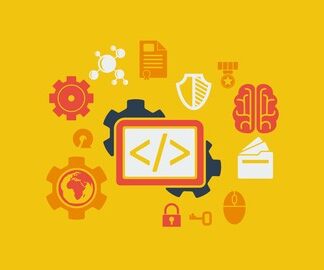Enroll in The Complete Python 3 Course: Beginner to Advanced!
Click here to subscribe for more videos like this!
So, the first thing that we need to do to get into programming in Python is installing it. So, let’s go ahead and discuss about the three different ways that you’re going to be installing it. First, we’re going to cover Mac because that’s what i’m using and so it’s easiest to show you how to do it. So, what you’re going to do is open up terminal which I’ve moved into that folder and put right here. Now, if you haven’t installed Homebrew, what you’re going to do is run a Ruby command that’s going to download and set it up. So, basically what Homebrew is, is a package manager that you can use to install a lot of packages. So, if you’re used to Linux basically on Linux if you want to install a package you don’t need to go all around the internet and search for packages on websites and then download from shady sources and get viruses, that’s just a bad construct of computer operating systems, but unfortunately that’s how Windows works and so i’m going to show you guys the right way to install in Windows as well. Using Linux or OS 10 you’re going to be installing through terminal. So, first setup Homebrew, this is how you do it, come to brew.sh and it’s going to give you this line of code here. You just paste this in terminal, run it, it’s going to install brew. Once you’ve got brew installed what you’re going to do is run “brew install python” Now that’s how easy it is. OS 10 does ship with a version of Python but the the version included in OS 10 is 2.7 series and I think it’s actually an old really something that’s like to 2.7.5 or something like that so it’s pretty old. At least I think it was that. We can actually run “–python version” here, so okay so the version that OS 10 El Capitan ships with is 2.7.10. When you run brew install Python it’s going to install python 3, that’s the command that we’re going to have to be using because there’s already a Python version installed, so we’re going to be using Python 3 and you can check the version we’ve got 3.5.1 that’s the version that homebrew is going to install for you. Now similarly if you’re on Linux what you would do there’s a few different ways because there’s a few different package managers. So if you’re on Arch Linux I don’t think you’re gonna need help setting it up, and actually a lot of Linux distributions have Python/Python 3 pre-installed, so you can just run “python –version” and “python3 –version” and see what version you have installed, you might need to upgrade, it it might be fine. If you have 3.4 you can follow along with this course I don’t think there’s that many differences between the two versions and there’s definitely not code-breaking differences, so that shouldn’t be a problem. However, if you do notice that you’re having a problem you could upgrade the version of Python either through the repository or otherwise. If you’re on Ubuntu you’re gonna be using the apt-get command, so you’d run “sudo apt-get install python3” That’s going to install Python 3 for you. If you’re on Fedora I believe it used to be yum, I think it’s dnf now. Yeah, so let’s just review exactly what commands you’re going to be using, I think it’s like dnf install. So, you can still use yum I guess, ok so you can use yum to install. So, what you’re gonna do is we’re gonna run “sudo yum install” and then I believe the package is just called python3, Python 4 is going to be pretty amazing but right now we’re using Python 3. So, there we go. Now if you’re on Arch and I said I don’t think you need any help getting it setup but just for you know if you are new to Arch you’d run “sudo pacman -S python3” but again python3 should be pre-installed, so you shouldn’t even need to do any of this but if you do that’s gonna do it. Now on Windows you do need to go download a file from the internet and run it, the the difference between what I said before what I’m saying now is this is not a shady location. So, what you’re going to do is go to python.org, go to the download sections, and if you just hover over this it’s actually going to show you a drop-down and you can choose what platform you’re on. So you would choose windows and they actually have a 3.6 which we’re not going to we’re not going to be using because this is in alpha. So, click latest python3 release python 3.5.1, it’s going to take you to this page and basically give you a changelog and whatnot. If you go down here make sure you get the version that’s compatible with your system. If you have a computer that is not obsolete it should be running a 64-bit operating system which means it has a 64-bit processor. So you would download this one right here, Windows x86 64 executable and what that’s going to download is an .exe file which you can use to install the program. If you’re running a 32-bit system you’re going to download this one just the x86, and yeah just install it. Now, there is one note on the installation, when you run the installation there’s going to be a certain step where you have some checkboxes and one of them is going to say add python to the path variable, make sure that’s checked because if it’s not checked if you try to run Python in the command line you won’t be able to because it won’t know where to find this mysterious Python command. So, by checking that box basically it tells windows where the Python binary file is located, so you want to make sure Windows is aware of where that file is. And that’s all there is to installing it. To confirm that you’ve got it installed open up a command prompt to terminal and just type Python3 and it should drop you down into the interpreter, which we’re going to be discussing in the next video.









